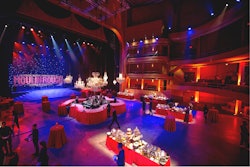
For the last four iterations of Fashion Week, Mike Brown of Lot71 has designed some of the festivities' most daring settings. For Adidas’s futuristic Y-3 line, he incorporated conveyor belts into the gymnasium at Hunter College and Pier 40, and he created an ethereal forest for Tommy Hilfiger at the Hammerstein Ballroom. This year, he switched gears, moving away from colder, more austere palettes to Miss Sixty’s rambunctious, colorful attire. The show was September 6.
How does working on Fashion Week differ from working on events and installations?
You are really pushed to come up with bold, singular ideas—like one brush stroke on a canvas. It has to be bold, sexy, and strong, and it has to underscore the collection. It’s only going to be around for 10 minutes and that’s it.
Where did you find your inspiration for the Miss Sixty show?
I gave them two distinct ideas, and the one they chose was a mod, '70s design. The inspiration came out of the collection and the colors and the patterns of the textiles, and out of my appreciation for the architecture of the Miss Sixty stores themselves. I also drew upon Verner Panton, the '70s architect and furniture designer who favored sleek, rounder shapes.
How do you keep the designs fresh from season to season?
For me, it stays fresh and new because I am working with different clients or a different physical space. Each venue provides a new sculptural, experiential landscape and a new challenge.
Speaking of new venues, Miss Sixty was in the tents, and your previous experience was in outside venues. How did that change the experience?
This was my first show in the tents. It was exciting because the parameters were so much more limited. For Y-3, you come into a venue for six days of loading and have an extensive palette to work with. Working on a limited scale inspires you to be creative in a different way.
What’s so limiting about the tents?
We were lucky: We had a morning slot, so we could start setup after the last show [the night before]. You still have to load out your scenery in an hour because the next show is coming in an hour. And if you have a show in the middle of the day, you have an hour and a half to load in your scenery.
What are the biggest challenges of Fashion Week?
The time availability, the production parameters—everyone is so busy. We would all prefer to have more lead time, more efficient decision making, but that’s also the adrenaline rush of the industry. You have to act quickly and come up with ideas quickly, but you also don’t obsess as much, and the work has a certain exciting quality as a result.



















